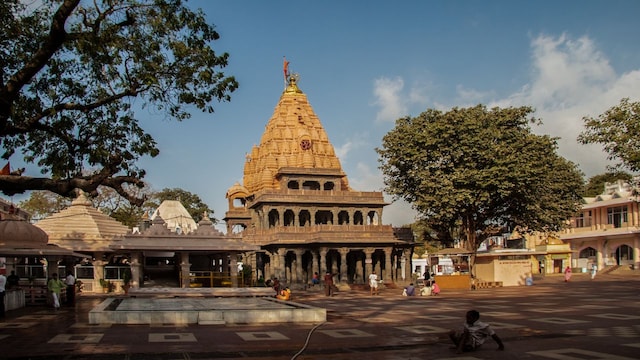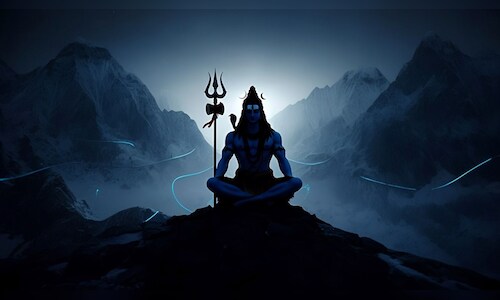
 1 / 13
1 / 13Maha Shivratri, the night dedicated to Lord Shiva, is counted as one of the most auspicious and sacred festivals in India. Usually observed on the 14th day of the dark fortnight of Phalguna, this year it falls on Wednesday, February 26. On this day, devotees observe a fast, meditate, offer prayers to the lord, and even visit Shiva temples to take part in the festivities. One of the key aspects of the festival is paying reverence to the 12 Jyotirlingas of Lord Shiva. Scattered across the country, visiting the Jyotirlingas is believed to bring divine blessings, remove obstacles, and ensure well-being for all. (Image: Shutterstock)

 2 / 13
2 / 131. Somnath Temple: The Somnath Temple in Gujarat holds the top position among 12 Aadi Jyotirlingas in the country. It is one of the most sacred pilgrimage sites built in the Chalukya style. The temple also finds a mention in ancient Shiva Purana and Rig Veda. (Image: Shutterstock)

 3 / 13
3 / 132. Nageshwar Temple: Located on the Saurashtra coast in Gujarat, the Nageswara Temple is also a famous Jyotirlinga temple, drawing thousands of visitors regularly. One of the key highlights of the temple is a 25-metre-tall statue of Lord Shiva surrounded by a spacious garden and stunning views of the Arabian Sea. The original temple is believed to be submerged under the water with the current structure erected on the same site. (Image: Shutterstock)

 4 / 13
4 / 133. Trimbakeshwar Temple: The Trimbakeshwar Jyotirlinga is situated at the same place where the Godavari river starts. According to the Shiva Purana, Gautam Rishi and Godavari River asked Lord Shiva to stay at the place, thus leading to the existence of Trimbakeshwar. The temple is unique for the three-phase lingam representing Shiva Brahma and Vishnu. (Image: Shutterstock)

 5 / 13
5 / 134. Bhimashankar Temple: Standing beside the Bhima River in Maharashtra’s Pune, the temple is built with black and red bricks in the Nagara style. The sacred Jyotirlinga in the temple is believed to date back to the 13th century and the sabhamandap was built in the 18th century by Nana Phadnavis. (Image: Shutterstock)

 6 / 13
6 / 135. Kashi Vishwanath Temple: The Kashi Vishwanath temple in Varanasi is a well-known Jyotirlinga Temple that attracts thousands of devotees on a regular basis. Standing near the sacred Ganga river, it is also known as the ‘Golden Temple of Varanasi’ due to its gold-plated dome. The temple’s history goes back 2,500 years. (Image: Reuters)

 7 / 13
7 / 136. Mahakaleshwar Temple: Located in Ujjain, the Mahakaleshwar temple is another significant Jyotirlinga in the country holding great spiritual significance among devotees. The temple dates back to the fourth century BC and is engraved with exquisite carvings and a self-manifested Shiva Linga. (Image: Shutterstock)

 8 / 13
8 / 137. Kedarnath Temple: The Kedarnath Temple is among the four Dhams in Hinduism where devotees travel frequently to offer holy water at Shiva Linga. Nestled in the Himalayas, it is accessible only by a challenging track. (Image: Shutterstock)

 9 / 13
9 / 138. Rameshwaram Temple: Located in Rameswaram, the temple is said to have been referred to by Lord Ram following his victory over demon king Ravana. Counted as the southernmost Jyotirlinga, the temple is surrounded by the sea and is admired for its stunning architecture and 33 theerthams. (Image: Shutterstock)

 10 / 13
10 / 139. Grishneshwar Temple: The temple is in Maharashtra’s Aurangabad built with red and black stones in the Shikara style. The temple originated in the 13th century while its current structure is attributed to Queen Ahilya Holkar. The magnificent five-storey temple is also referred to as Gru Someswara or Kusum Eswarar. (Image: Shutterstock)

 11 / 13
11 / 1310. Omkareshwar Temple: The fourth Jyotirlinga among the 12 of Lord Shiva is located in Omkareshwar, Madhya Pradesh. It also finds mention in ancient streets like Skanda Purana, Shiva Purana, and Vayu Purana. It is believed that Lord Shiva after traversing the three worlds used to rest here, thus special sleeping arrangements, rituals, and Shayan Darshan of the deity have been arranged here. (Image: Shutterstock)

 12 / 13
12 / 1311. Baidyanath Temple: The Baidyanath Jyotirlinga Temple is located in Jharkhand. It is revered as the ‘healer,’ attracting devotees who offer blessings for their well-being and spiritual growth. Also, referred to as one of the Shakti Peethas, the temple is associated with the divine power of Goddess Sati, making the unique confluence of Shiva and Shakti. (Image: Shutterstock)

 13 / 13
13 / 1312. Mallikarjuna Temple: The temple stands tall near River Krishna in Srisailam. Famously known for its beautiful architecture, the temple is filled with several sculptures and special pillars. One of the most unique features is that the temple shares the same complex with one of the Maha Shakti Peethas. (Image: Shutterstock)


